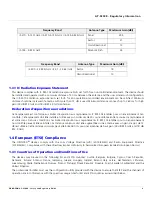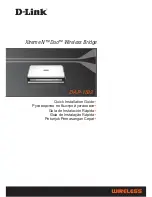
AP-9200R - Regulatory Information
ORiNOCO® AP- 9200R - Safety and Regulatory Guide
7
1.2.2 FCC Radiation Exposure Statement
The ORiNOCO
®
devices comply with FCC radiation exposure limits set forth for an uncontrolled environment.
Tabulated below are the products and the FCC radiation exposure limits followed by the devices:
1.2.3 Installation within TDWR Range
Before mounting and installing the device, please check the distance between the device location and the near by Terminal
Doppler Weather Radar (TDWR). You can find the locations of the airport weather radars from the Wireless Internet Service
Providers Association (WISPA) database at
http://spectrumbridge.com/udrs/home.aspx
. If the distance from the device to any
TDWR is less than 35 kms, then the radio is not allowed to operate in channels closer than 30 MHz relative to the TDWR
frequency (above and below). To protect these TDWR, the channels up to 30 MHz must be blacklisted so they cannot be
selected as operational channel. In addition to blacklisting of the channels, register the location of the device radio in the
WISPA database, so that any interference caused by the operation of the radio can be addressed in compliance with the Part
15 requirements.
For example
: Consider the TDWR location at Phoenix, AZ operating at 5610 MHz (N 33 25 14; W 112 09 46). If the device
is installed within 35 kms radial distance from this location then avoid operating in 5580 - 5640 MHz band. Also, blacklist all
channels overlapping the 5580 - 5600 MHz band (5600 - 5650 is already removed from operation list of our device).
1.3 Industry Canada Compliance
The ORiNOCO
®
devices comply with Canadian ICES-003 and license-exempt RSS standard(s).
The device operation is subject to the following conditions:
•
This device may not cause interference
•
This device must accept any interference, including interference that may cause undesired operation of the device
WARNING:
•
High-power radars are allocated as primary users (i.e. priority users) of the bands 5250-5350 MHz and
5650-5850 MHz and that these radars could cause interference and/or damage to LE-LAN devices.
NOTES:
•
This device and its antenna(s) must not be co-located or operated in conjunction with any other antenna or
transmitter.
Product(s)
Standards
AP-9200R
•
Product models using external antennas require professional
installation. The antennas used for professional installation
must be fixed-mounted on outdoor permanent structures with
a minimum separation distance of 25 cm from the antenna to
the users. Separation distance should be increased if antenna
with more than 13 dBi is used. Separation distance can reach
up to 260 cm for high gain (34 dBi @ 5 GHz and 18 dBi @
2.4 GHz) antennas.
•
Antennas must not be co-located and must not operate in
conjunction with any other antenna or transmitter.
Summary of Contents for ORiNOCO AP-9200R
Page 1: ...ORiNOCO AP 9200R Outdoor Access Point Safety Regulatory Guide ...
Page 15: ...Canada Certification ORiNOCO AP 9200R Safety and Regulatory Guide 15 ...
Page 16: ...Canada Certification ORiNOCO AP 9200R Safety and Regulatory Guide 16 ...
Page 17: ...Canada Certification ORiNOCO AP 9200R Safety and Regulatory Guide 17 ...
Page 18: ...Canada Certification ORiNOCO AP 9200R Safety and Regulatory Guide 18 ...
Page 20: ...USA Certification ORiNOCO AP 9200R Safety and Regulatory Guide 20 ...
Page 21: ...USA Certification ORiNOCO AP 9200R Safety and Regulatory Guide 21 ...
Page 23: ...ETSI Certification ORiNOCO AP 9200R Safety and Regulatory Guide 23 ...
Page 24: ...ETSI Certification ORiNOCO AP 9200R Safety and Regulatory Guide 24 ...
Page 26: ...UL Certification ORiNOCO AP 9200R Safety and Regulatory Guide 26 ...
Page 27: ...UL Certification ORiNOCO AP 9200R Safety and Regulatory Guide 27 ...
Page 29: ...CB Test Certificate ORiNOCO AP 9200R Safety and Regulatory Guide 29 ...
Page 30: ...CB Test Certificate ORiNOCO AP 9200R Safety and Regulatory Guide 30 ...








































